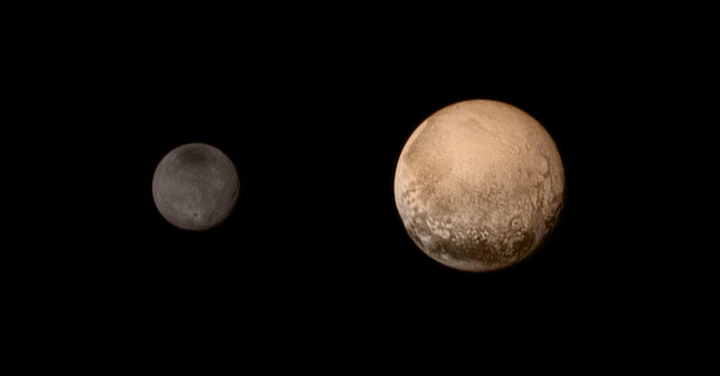
View pictures in App save up to 80% data.
Around 4.5 billion years ago, Pluto, the dwarf planet, encountered a companion in a sudden and remarkable event. For a fleeting moment – likely just a few hours – they twirled together in a cosmic embrace, performing a graceful do-si-do before drifting apart. This celestial dance ultimately led to the formation of Pluto and its five moons, which now orbit the sun in harmony.
For many years, astronomers have been curious about the origin of Charon, the largest moon of Pluto, and its orbit around the dwarf planet. A recent study released on Monday in the journal Nature Geoscience proposed a potential series of events that could explain this intriguing phenomenon.
"Adeene Denton, a planetary scientist from the University of Arizona who spearheaded the research, remarked, 'What makes Pluto and Charon particularly fascinating is that Charon is half the size of Pluto. The only similar example we have is the Earth and its moon.'"
Charon measures approximately 750 miles in width, whereas Pluto has a diameter of nearly 1,500 miles. This size ratio indicates that several traditional theories regarding moon formation may not apply, such as the ideas that Charon originated from debris surrounding Pluto or was gravitationally captured by it. Might Charon's presence be better accounted for by a collision scenario similar to the one thought to have created Earth's moon?
According to Erik Asphaug, a planetary scientist from the University of Arizona and a co-author of the study, the dimensions of Pluto and Charon posed challenges in understanding why they "didn't simply combine like two droplets of liquid," which would be the expected result in such a cataclysmic situation.
Pluto and Charon reside in the Kuiper belt, an area in the outer solar system located past Neptune, characterized by its rocky and icy composition. By incorporating these features into their model, the research team formulated a scenario where the two celestial bodies collided and became trapped together without actually merging.
If Charon collided with Pluto at a leisurely pace of approximately 2,000 mph—ten times slower than the impact that created Earth's moon—the two celestial bodies would have stayed in contact for around 10 hours before slowly drifting apart, yet still maintaining a gravitational bond. The scientists referred to this event as a “kiss and capture.”
Denton explained that the resilience of the two bodies kept them intact. At that time, Pluto would have completed a rotation every three hours (in contrast, a day on Pluto now lasts about 150 hours), meaning the two bodies would have orbited each other three times while still connected.
The angular momentum generated by Pluto's rotation would have gradually pushed Charon further away, while still keeping it securely within Pluto's orbital path.
Bill McKinnon, a planetary scientist from Washington University in St. Louis, remarked that this scenario is quite plausible, considering the vast number of objects that are thought to be floating in the Kuiper belt during the early stages of the solar system. He noted, "Collisional capture is likely a frequent occurrence," adding that many other significant binary objects are also believed to be present in the Kuiper belt.
According to Denton, the consequences would have resulted in "essentially a complete resurfacing of Pluto." She noted that Charon would lose a significant portion of its surface ice to its neighboring body. "This impact serves as a geological reset for the entire system," she explained.
This could have also led to the creation of Pluto's four other recognized moons – Nix, Styx, Kerberos, and Hydra – which are significantly smaller than Charon and were observed during NASA's New Horizons spacecraft's flyby of Pluto in 2015.
The model developed by the team may provide a fresh perspective on the phenomenon of certain moons orbiting different celestial bodies. “This introduces an intriguing new angle to the physics involved,” noted Asphaug. “We’ve long believed that the strength of materials is irrelevant during collisions. It’s time to reassess that belief, particularly in the context of our moon’s formation.”
A more in-depth examination of Pluto could reveal whether its celestial movements actually occurred, but it may be quite some time before another spacecraft arrives at the dwarf planet.
Denton stated, “If Charon were to have transferred some of its rock material to Pluto, we could detect that through gravity measurements. Sadly, we would need to return to Pluto to verify this.”
This article originally appeared in The New York Times.